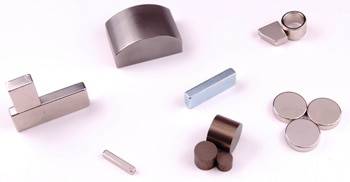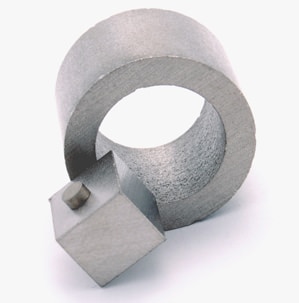The term rare earth magnet is a generic name used to describe two types of magnetic material: samarium cobalt and neodymium iron boron. Both of these magnetic alloys utilize rare earth elements as the magnetic constituents and the characteristics offered by both material types lend themselves to specific applications.
Over 30 years ago, neodymium magnets were developed by General Motors and Sumitomo Specialty Metals in response to the rising cost of samarium cobalt. Since its inception, neodymium iron boron has undergone a numerous enhancements, and today, this material is the most popular and widely used magnet alloy. It’s also important to know that there are hundreds of patents covering the production of sintered neodymium iron boron magnets. Here at Dura, the neodymium iron boron we supply is licensed and compliant to all applicable patents.
Of all magnetic materials (including other rare earths), neodymium iron boron offers the highest available magnetic energy density with (BH)Max values ranging from 33 to 52 MGOe. This physical property allows designers to use relatively small amounts of magnetic alloy when compared to other magnetic materials. Although the smaller magnets and increased savings associated with neodymium might suggest choosing a high strength neodymium magnet is the best choice for all applications, this is not always the case. Ignoring important characteristics such as operating temperature or the magnet’s ability to withstand corrosion may cause premature failure and substandard performance. Alternative high temperature grades of neodymium iron boron and various surface treatments are available when the rigors of the application demand it.
Other than the fact that both are called rare earth magnets, there are few similarities between samarium cobalt and neodymium iron boron. Samarium cobalt offers the second highest energy density, with BHMax values ranging from 16 to 32 MGOe, but SmCo magnets are also very brittle. Due to this physical characteristic, designers and engineers must exercise great care when integrating samarium cobalt magnets with a given application. Samarium cobalt also sets itself apart from other magnet materials (including neodymium iron boron) because of its capacity to function at elevated temperatures up to 662°F. Samarium cobalt is often the rare earth magnet alloy of choice for high strength/ high temperature applications.
The different magnetic and physical properties of these two magnetic alloys means that choosing the proper rare earth magnet is more complex than locating an online vendor offering a suitable size. Ultimately, selecting the proper rare earth magnet is application driven, and your best bet is to speak with an engineer to discuss your specific needs.
The differences and potential trade-offs between neodymium and samarium cobalt rare earth magnets are perfectly illustrated by a recent customer phone call. In this case, our customer inquired about a neodymium magnet because his application required a high strength part that would function through a gap (magnets typically don’t work well through gaps). The application will also subject the magnets to high temperatures that exceed the maximum operating temperature for most grades of neodymium.
Our customer was also interested in samarium cobalt due to the material’s higher maximum operating temperature. At first glance, this makes sense, but it fails to take into consideration mechanical strength—remember, samarium cobalt magnets are brittle. As you can see, there isn’t an easy ‘one size fits all’ solution to our customer’s application. The high magnetic strength of neodymium made it initially attractive and the significantly higher operating temperature of samarium cobalt was an intriguing option. To arrive at a true “best fit” for this application, we’ll need to explore additional considerations, including cost, longevity, and unique shape requirements that may add cost and/or create installation issues.
Most of the major magnet manufacturers (including Dura) offer charts and data describing the physical characteristics of available magnets grades, including rare earth magnets. This information is a huge help when selecting a rare earth magnet, but it is only a starting point. To optimize your rare earth magnet design for cost, performance, and heat resistance, speaking with a magnetic engineer is the best way to ensure your rare earth magnet will meet your specific needs. Often, only a brief explanation of your application is all that is needed for a member of our design team to recommend the best grade of samarium cobalt or neodymium iron boron. Put our 50 plus years of experience to work for you!



